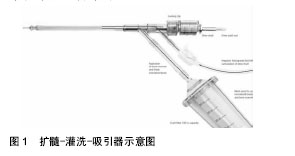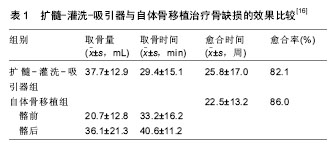| [1] Green J.History and development of suction-irrigation-reaming.Injury.2010;41(41 Supple2): S24-31.[2] Miller MA,Ivkovic A,Porter R,et al.Autologous bone grafting on steroids:preliminary clinical results.A novel treatment for nonunions and segmental bone defects.Int Orthop. 2011; 35(4):599-605.[3] Lowe JA,Rocca GJ,Murtha Y,et al.Complications associated with negative pressure reaming for harvesting autologous bone graft:a case series.J Orthop Trauma.2010;24(1):46-52.[4] Barlow,Brian T,Kevin M.Technique and indications for the retrograde use of the reamer-irrigator-aspirator.Current Orthopaedic Practice.2014;25(Issue)183-188.[5] Cox G,Jones E,Mcgonagle D,et al.Reamer-irrigator-aspirator indications and clinical results: a systematic review.Inter Orthopaedics.2011;35(7):951-956.[6] Kuhn KM,Barlow BT,Dromsky D.The Reamer-Irrigator-Aspirator: roles and evidence supporting its use in current orthopaedic practice.Surgery Curr Res. 2014; 4(2):167-172.[7] Zalavras CG,Singh A,Patzakis MJ.Novel technique for medullary canal debridement in tibia and femur osteomyelitis.Clin Orthop Relat Res.2007;461(461):31-34.[8] Cipriano CA,Arvanitis LD,Virkus WW.Use of the reamer-irrigator-aspirator may reduce tumor dissemination during intramedullary fixation of malignancies.Orthopedics. 2012;35(1):48-52.[9] Lowe JA,Vosburg C,Murtha YM,et al.A new technique for removing intramedullary cement.J Orthop Trauma. 2011; 25(12):762-766.[10] Higgins TF,Casey V,Bachus K.Cortical heat generation using an irrigating/aspirating single-pass reaming vs conventional stepwise reaming.J Orthop Trauma.2007;21(3):192-197.[11] Husebye EE,Lyberg T,Madsen JE,et al.The influence of a one-step reamer-irrigator-aspirator technique on the intramedullary pressure in the pig femur.Injury. 2006;37(10): 935-940.[12] Wang RY,Li R,Zdero R,et al.The physiologic and pathologic effects of the reamer irrigator aspirator on fat embolism outcome:an animal study.J Orthopaedic Trauma. 2012;26(9): 132-137.[13] Pape HC,Zelle BA,Hildebrand F,et al.Reamed femoral nailing in sheep:does irrigation and aspiration of intramedullary contents alter the systemic response?.J Bone Joint Surg(Am). 2005;87(11):2515-2522.[14] Volgas DA,Burch T,Stannard JP,et al.Fat embolus in femur fractures:a comparison of two reaming systems.Injury. 2010; 41(Suppl 2):S90-93. [15] Han F,Peter L,Lau ETC,et al.Reamer Irrigator Aspirator bone graft harvesting: complications and outcomes in an Asian population.Injury.2015;46(10):2042-2051.[16] Dawson J,Kiner D,Nd GW,et al.The reamer irrigator aspirator as a device for harvesting bone graft compared with iliac crest bone graft:union rates and complications.J Orthopaedic Trauma.2014;28 (10):584-590.[17] Beck A,Nehrbass D,Stoddart MJ,et al.The use of Reamer Irrigator Aspirator (RIA) autograft harvest in the treatment of critical-sized iliac wing defects in sheep:investigation of dexamethasone and beta-tricalcium phosphate augmentation. Bone.2013;53(2):554-565.[18] Qvick LM,Ritter CA,Mutty CE,et al.Donor site morbidity with reamer-irrigator-aspirator (RIA) use for autogenous bone graft harvesting in a single centre 204 case series.Injury. 2013; 44(10):1263.[19] Calori GM, Colombo M,Mazza EL,et al.Incidence of donor site morbidity following harvesting from iliac crest or RIA graft. Injury. 2014;45(Suppl 6):S116-120.[20] Jakoi AM,Iorio JA,Cahill J.Autologous bone graft harvesting: a review of grafts and surgical techniques.Musculoskel Surg. 2015;99(3:171-178.[21] Toosi S,Naderi-Meshkin H,Kalalinia F,et al.Comparative characteristics of mesenchymal stem cells derived from Reamer-irrigator-aspirator,iliac crest bone marrow,and adipose tissue.Cell Mol Biol.2016;62(10):68-74.[22] Porter RM,Liu F,Pilapil C,et al.Osteogenic potential of reamer irrigator aspirator (RIA) aspirate collected from patients undergoing hip arthroplasty.J Orthop Res.2009;27(1):42-49.[23] Churchman SM,Kouroupis D,Boxall SA,et al.Yield optimisation and molecular characterisation of uaspirator waste bag.Eur Cell Mater.2013;13(26):252-262.[24] Cox G,McGonagle D,Boxall SA,et al.The use of the reamer-irrigator-aspirator to harvest mesenchymal stem cells.J Bone Joint Surg(Br).2011;93B(4):517-524.[25] Van dBR, Blokhuis TJ.Increased osteogenic capacity of Reamer/Irrigator/Aspirator derived mesenchymal stem cells.Injury.2014;45(12):2060.[26] Hammer TO,Wieling R,Green JM,et al.Effect of re-implanted particles from intramedullary reaming on mechanical properties and callus formation.A laboratory study.J Bone Joint Surg(Br).2007; 89B(11):1534-1538.[27] Stafford PR,Norris BL.Reamer-irrigator-aspirator bone graft and bi Masquelet technique for segmental bone defect nonunions:a review of 25 cases.Injury.2010;41(Suppl 2):S72.[28] Kanakaris N,Gudipati S,Tosounidis T,et al.The treatment of intramedullary osteomyelitis of the femur and tibia using the Reamer-Irrigator-Aspirator system and antibiotic cement rods. Bone Joint J.2014;96B:783-788.[29] Gualdrini G,Barchetti M,Trono M,et al.Intramedullary reaming in the treatment of chronic osteomyelitis of the femur and tibia.La Chirurgia Degli Organi Di Movimento.2000;85(3):257.[30] Granes R,Maurer TB,Mueller U,et al.Intrameduallary reaming as treatment of chronic osteomyelitis of long bones-a 10 to 15 years follow-up.J Veterinary Emergency Critical Care. 2006; 24(2):134-134.[31] Tosounidis TH,Calori GM,Giannoudis PV.The use of Reamer-irrigator-aspirator in the management of long bone osteomyelitis:an update.Eur J Trauma Emerg Surg. 2016; 42(4):417-423.[32] Dalgorf D,Borkhoff CM,Stephen DJ,et al.Venting during prophylactic nailing for femoral metastases:current orthopedic practice.Can J Surg.2003;46(6):427-431.[33] McCall TA,Brokaw DS,Jelen BA,et al.Treatment of large segmental bone defects with reamer-irrigator-aspirator bone graft:technique and case series.Orthop Clin North Am. 2010; 41(1):63-73.[34] Jakma TSC,Roling MA,Punt B,et al.More adverse events than expected in the outcome after use of the reamer-irrigator-aspirator.Eur J Trauma Emerg Surg. 2013; 40(3):337-341.[35] Marchand LS,Rothberg DL,Kubiak EN, et al.Is This autograft worth it?: The blood loss and transfusion rates associated with reamer irrigator aspirator bone graft harvest.J Orthop Trauma.2017;31(4):205-209.[36] Donders JC,Baumann HM,Stevens MF,et al. Hemorrhagic-induced cardiovascular complications during reamer-irrigator-aspirator-assisted femoral nonunion treatment.J Orthop Trauma.2016;30(9):e294-298.[37] Sagi HC,Young ML,Gerstenfeld L,et al.Qualitative and quantitative differences between bone graft obtained from the medullary canal (with a Reamer/Irrigator/Aspirator) and the iliac crest of the same patient.J Bone Joint Surg(Am). 2012; 94(23):2128-2135.[38] Kuehlfluck P,Moghaddam A,Helbig L,et al.RIA fractions contain mesenchymal stroma cells with high osteogenic potency.Injury.2015;46(Suppl 8):S23-32. |
.jpg)


.jpg)